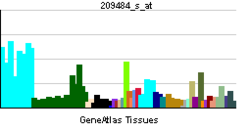- NSL1
-
NSL1, MIND kinetochore complex component, homolog (S. cerevisiae) Identifiers Symbols NSL1; C1orf48; DKFZp566O1646; MIS14 External IDs OMIM: 609174 MGI: 2685830 HomoloGene: 22898 GeneCards: NSL1 Gene Gene Ontology Molecular function • protein binding Cellular component • MIS12/MIND type complex
• nucleus
• chromosome
• cytosolBiological process • M phase of mitotic cell cycle
• mitotic prometaphase
• mitotic cell cycle
• chromosome segregation
• cell divisionSources: Amigo / QuickGO RNA expression pattern 
More reference expression data Orthologs Species Human Mouse Entrez 25936 381318 Ensembl ENSG00000117697 ENSMUSG00000062510 UniProt Q96IY1 Q8K305 RefSeq (mRNA) NM_001042549.1 NM_198654.3 RefSeq (protein) NP_001036014.1 NP_941056.3 Location (UCSC) Chr 1:
212.9 – 212.97 MbChr 1:
192.89 – 192.91 MbPubMed search [1] [2] Kinetochore-associated protein NSL1 homolog is a protein that in humans is encoded by the NSL1 gene.[1]
This gene encodes a protein with two coiled-coil domains that localizes to kinetochores, which are chromosome-associated structures that attach to microtubules and mediate chromosome movements during cell division. The encoded protein is part of a conserved protein complex that includes two chromodomain-containing proteins and a component of the outer plate of the kinetochore. This protein complex is proposed to bridge centromeric heterochromatin with the outer kinetochore structure. Multiple transcript variants encoding different isoforms have been found for this gene.[1]
Interactions
NSL1 has been shown to interact with MIS12[2] and DSN1.[2]
References
- ^ a b "Entrez Gene: NSL1 NSL1, MIND kinetochore complex component, homolog (S. cerevisiae)". http://www.ncbi.nlm.nih.gov/sites/entrez?Db=gene&Cmd=ShowDetailView&TermToSearch=25936.
- ^ a b Obuse, Chikashi; Iwasaki Osamu, Kiyomitsu Tomomi, Goshima Gohta, Toyoda Yusuke, Yanagida Mitsuhiro (Nov. 2004). "A conserved Mis12 centromere complex is linked to heterochromatic HP1 and outer kinetochore protein Zwint-1". Nat. Cell Biol. (England) 6 (11): 1135–41. doi:10.1038/ncb1187. ISSN 1465-7392. PMID 15502821.
Further reading
- Maruyama K, Sugano S (1994). "Oligo-capping: a simple method to replace the cap structure of eukaryotic mRNAs with oligoribonucleotides.". Gene 138 (1-2): 171–4. doi:10.1016/0378-1119(94)90802-8. PMID 8125298.
- Suzuki Y, Yoshitomo-Nakagawa K, Maruyama K, et al. (1997). "Construction and characterization of a full length-enriched and a 5'-end-enriched cDNA library.". Gene 200 (1-2): 149–56. doi:10.1016/S0378-1119(97)00411-3. PMID 9373149.
- Strausberg RL, Feingold EA, Grouse LH, et al. (2003). "Generation and initial analysis of more than 15,000 full-length human and mouse cDNA sequences.". Proc. Natl. Acad. Sci. U.S.A. 99 (26): 16899–903. doi:10.1073/pnas.242603899. PMC 139241. PMID 12477932. http://www.pubmedcentral.nih.gov/articlerender.fcgi?tool=pmcentrez&artid=139241.
- Ota T, Suzuki Y, Nishikawa T, et al. (2004). "Complete sequencing and characterization of 21,243 full-length human cDNAs.". Nat. Genet. 36 (1): 40–5. doi:10.1038/ng1285. PMID 14702039.
- Gerhard DS, Wagner L, Feingold EA, et al. (2004). "The status, quality, and expansion of the NIH full-length cDNA project: the Mammalian Gene Collection (MGC).". Genome Res. 14 (10B): 2121–7. doi:10.1101/gr.2596504. PMC 528928. PMID 15489334. http://www.pubmedcentral.nih.gov/articlerender.fcgi?tool=pmcentrez&artid=528928.
- Obuse C, Iwasaki O, Kiyomitsu T, et al. (2004). "A conserved Mis12 centromere complex is linked to heterochromatic HP1 and outer kinetochore protein Zwint-1.". Nat. Cell Biol. 6 (11): 1135–41. doi:10.1038/ncb1187. PMID 15502821.
- Kimura K, Wakamatsu A, Suzuki Y, et al. (2006). "Diversification of transcriptional modulation: large-scale identification and characterization of putative alternative promoters of human genes.". Genome Res. 16 (1): 55–65. doi:10.1101/gr.4039406. PMC 1356129. PMID 16344560. http://www.pubmedcentral.nih.gov/articlerender.fcgi?tool=pmcentrez&artid=1356129.
- Nousiainen M, Silljé HH, Sauer G, et al. (2006). "Phosphoproteome analysis of the human mitotic spindle.". Proc. Natl. Acad. Sci. U.S.A. 103 (14): 5391–6. doi:10.1073/pnas.0507066103. PMC 1459365. PMID 16565220. http://www.pubmedcentral.nih.gov/articlerender.fcgi?tool=pmcentrez&artid=1459365.
- Kline SL, Cheeseman IM, Hori T, et al. (2006). "The human Mis12 complex is required for kinetochore assembly and proper chromosome segregation.". J. Cell Biol. 173 (1): 9–17. doi:10.1083/jcb.200509158. PMC 2063780. PMID 16585270. http://www.pubmedcentral.nih.gov/articlerender.fcgi?tool=pmcentrez&artid=2063780.
- Gregory SG, Barlow KF, McLay KE, et al. (2006). "The DNA sequence and biological annotation of human chromosome 1.". Nature 441 (7091): 315–21. doi:10.1038/nature04727. PMID 16710414.
- Grundt K, Haga IV, Huitfeldt HS, Ostvold AC (2007). "Identification and characterization of two putative nuclear localization signals (NLS) in the DNA-binding protein NUCKS.". Biochim. Biophys. Acta 1773 (9): 1398–406. doi:10.1016/j.bbamcr.2007.05.013. PMID 17604136.
Categories:- Human proteins
- Chromosome 1 gene stubs
Wikimedia Foundation. 2010.
